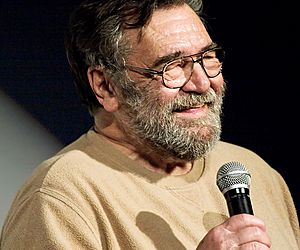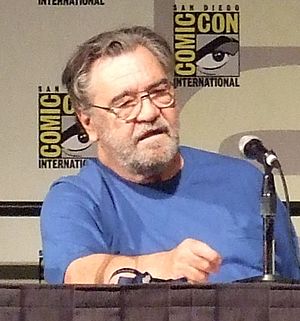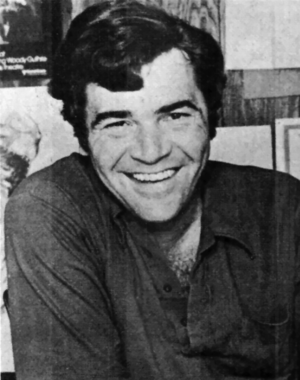Ralph Bakshi facts for kids
Quick facts for kids
Ralph Bakshi
|
|
|---|---|
| ראלף בקשי | |

Bakshi in January 2009
|
|
| Born | October 29, 1938 |
| Occupation |
|
| Years active | 1956–2015 (animation) 1953–present (artist) |
|
Notable work
|
|
| Style |
|
| Spouse(s) |
|
| Children | 4 |
| Relatives | Miles Bakshi (grandson) Gina Shay (daughter-in-law) |
| Awards | Inkpot Award (2008) |
Ralph Bakshi (born October 29, 1938) is an American animator and filmmaker. He is famous for creating animated films that were very different from the cartoons people were used to seeing. In the 1970s, he made a name for himself by producing independent and adult-oriented animated movies.
Between 1972 and 1994, he directed nine feature films. Many of his movies were dramas set in cities or fantasy adventures. He also worked on many television shows as a director, writer, and animator.
Bakshi started his career at the Terrytoons cartoon studio. He worked his way up from a cel polisher to an animator and then a director. In 1968, he started his own studio, Bakshi Productions. His first feature film was Fritz the Cat (1972). It was the first animated movie to receive an X rating and became the most successful independent animated film ever.
He went on to direct other well-known films like Wizards (1977), The Lord of the Rings (1978), American Pop (1981), and Fire and Ice (1983). In 1987, he produced the TV series Mighty Mouse: The New Adventures. After a break from movies, he directed Cool World (1992).
In the 2000s, Bakshi focused more on painting. In 2003, he co-founded the Bakshi School of Animation. He has won several awards for his work, including an Annie Award for his contributions to animation.
Contents
Early life
Ralph Bakshi was born on October 29, 1938, in Haifa, which was then part of the British Mandate of Palestine. His family was Krymchak Jewish. In 1939, his family moved to the United States. He grew up in the Brownsville neighborhood of Brooklyn, New York.
Living in the city fascinated Bakshi. As a child, he loved comic books and would often search for them in trash cans. He said he loved the faded colors of the old wooden buildings and crates in his neighborhood. He even built his own toys from scrap wood.
In 1947, his family moved to a black neighborhood in Washington, D.C. Bakshi remembered, "All my friends were black... I went to see black movies; black girls sat on my lap. I went to black parties. I was another black kid on the block. No problem!"
Because schools were segregated by race, the nearest white school was far away. Bakshi got his mother's permission to attend the nearby black school with his friends. However, this was against the rules at the time, and the police removed him from the school. Soon after, his family moved back to Brownsville.
At fifteen, Bakshi found a book called Complete Guide to Cartooning and taught himself how to draw cartoons. He used his art to express his experiences and create fantasy worlds. He graduated from the School of Industrial Art (now the High School of Art and Design) in 1956 with an award in cartooning.
Career
Starting at Terrytoons
At 18, Bakshi was hired at the Terrytoons cartoon studio as a cel polisher. A cel is a clear plastic sheet that animators draw on. His job was to clean the cels. He was later promoted to cel painter.
Bakshi wanted to become an animator and practiced in his spare time. The other animators at the studio noticed his talent and helped him. He eventually became a director at the age of 25. One of his first projects was directing the series Sad Cat.
In 1966, Bakshi pitched an idea for a superhero parody called The Mighty Heroes to CBS. The network loved it and asked him to be the creative director for the show. The show was a success, but Bakshi wanted more creative control and decided to leave Terrytoons to start his own company.
Bakshi Productions and Fritz the Cat
Bakshi started his own studio, Bakshi Productions, in 1968. The studio worked on TV shows like Rocket Robin Hood and Spider-Man. But Bakshi wanted to create something more personal. He developed an idea for a film called Heavy Traffic, about life in the city.
Producer Steve Krantz told Bakshi that studios wouldn't fund the film because of its mature themes. Krantz suggested Bakshi first adapt an existing work. Bakshi found a comic book called Fritz the Cat by Robert Crumb. He loved its sharp humor and thought it would make a great movie.
After some difficulty, Krantz got the film rights. Warner Bros. initially agreed to fund the movie but later backed out. Krantz then made a deal with Jerry Gross, who owned a company that distributed exploitation films. Gross agreed to fund and distribute Fritz the Cat.
The film's backgrounds were made by tracing photographs of real places in New York City, giving it a realistic look. This was a new technique in animation. The movie was a huge hit and became the most successful independent animated film of all time.
Heavy Traffic
After the success of Fritz the Cat, Bakshi made Heavy Traffic. The film was inspired by his time playing pinball in arcades. It tells the story of a young underground cartoonist.
The film used a mix of animation and live-action footage. Like his first film, it was aimed at adults and did well at the box office. Bakshi became the first animator since Walt Disney to have two successful movies in a row. Critics praised the film. The Hollywood Reporter called it "an authentic work of movie art."
...skin
In 1973, Bakshi began working on a film called Harlem Nights, which was later renamed ...skin. The film was based on his experiences with racism and was meant to attack stereotypes. He cast actors like Scatman Crothers and Barry White in the film.
The movie used images from blackface history to make a point about racism. It also criticized the Mafia. Bakshi hired several African-American animators to work on the film, including Brenda Banks, the first African-American female animator.
The film's release was delayed because of protests from groups who felt the film was racist. When it was finally released, it had a limited showing and did not do well at first. However, some critics gave it positive reviews. The New York Times said it "could be [Bakshi's] masterpiece." Bakshi himself called ...skin his best film.
Shift to Fantasy Films
In 1976, Bakshi decided to make a fantasy film to show he could create a "family picture." He pitched Wizards to 20th Century Fox. The film was about a battle between two wizard brothers, one good and one evil.
To save money on the big battle scenes, Bakshi used a technique called rotoscoping. This is where animators trace over live-action footage. He used footage from old war movies and traced it to create the animated battles.
When the film was almost finished, George Lucas asked Bakshi to change the title from War Wizards to just Wizards to avoid confusion with his movie, Star Wars. Bakshi agreed. Wizards was a success and gained a worldwide following.
Next, Bakshi directed an animated version of The Lord of the Rings (1978). He wanted to make a serious adaptation of J. R. R. Tolkien's book. He shot the entire film with live actors and then used rotoscoping to animate it.
The film was a big project and had a tight schedule. When it was released, the studio marketed it as a complete story, even though it only covered the first half of the book series. Reviews were mixed, but the film was a financial success. However, the studio decided not to fund a sequel.
American Pop and Fire and Ice
After The Lord of the Rings, Bakshi made American Pop (1981). The film tells the story of four generations of a Russian-Jewish immigrant family of musicians. Their story is set against the history of American popular music.
Bakshi again used rotoscoping to capture realistic movements and emotions. The film featured a popular soundtrack with songs from artists like Janis Joplin and The Doors. American Pop was a success, and critics praised it.
In 1982, Bakshi teamed up with fantasy artist Frank Frazetta to create Fire and Ice (1983). The film was an action-oriented fantasy story. Bakshi and Frazetta were both very involved in the production, which also used rotoscoping to match Frazetta's art style. The film was not a financial success.
Return to Television
In 1987, Bakshi created a new version of an old cartoon character with Mighty Mouse: The New Adventures. He hired a team of young, talented animators, including John Kricfalusi, who would later create The Ren & Stimpy Show.
The show was known for its unique humor and art style. It was praised by critics and won an award from Action for Children's Television. However, the show was canceled after a controversy arose over a scene that some people thought was inappropriate.
Bakshi also directed a TV special based on Dr. Seuss's The Butter Battle Book. Dr. Seuss (Ted Geisel) himself worked on the storyboards and was happy with the final result.
Cool World and Later Career

In 1990, Bakshi began work on Cool World, a film that mixed live-action and animation. The story was about a cartoonist who gets pulled into the cartoon world he created. The film starred Kim Basinger and Brad Pitt.
Bakshi had creative disagreements with the studio, Paramount Pictures, and the final film was very different from his original idea. Cool World received negative reviews and was not a box office success.
After Cool World, Bakshi directed a live-action TV movie called Cool and the Crazy (1994) and an animated series for HBO called Spicy City (1997). After Spicy City was canceled, Bakshi retired from animation to focus on his painting.
In 2013, he used the website Kickstarter to fund a new animated film, Last Days of Coney Island. The film was released online in 2015.
Legacy
Ralph Bakshi changed the world of animation. He proved that cartoons could be for adults and could tell serious, complex stories. His unique visual style, which often mixed animation with live-action and photography, influenced many other filmmakers and animators.
Filmmakers like Quentin Tarantino and Gore Verbinski have praised his work. His films are often shown at special screenings, and his art has been collected in a book called Unfiltered: The Complete Ralph Bakshi. Even though he is no longer making major films, his impact on animation is still felt today.
Images for kids
See also
 In Spanish: Ralph Bakshi para niños
In Spanish: Ralph Bakshi para niños



